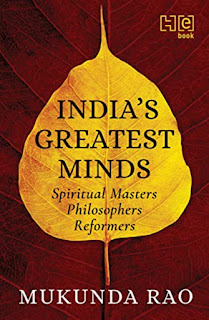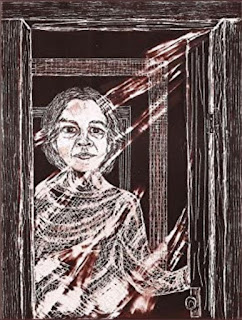The God with Feet of Clay?
The Times of India, Spectrum, Sunday Review, June 30, 1991
By Mahesh Bhatt
The daughter of Rajagopal, J. Krishnamurti's earliest believer, who later got disenchanted by him, lays bare his little-known secrets. The noted film maker presents portions from her recent book on the double life of the great philosopher-seer.
One night, almost a decade ago in the beautiful mountains of Kodai, near a fireplace in our living room, U.G. made an epoch-making statement on J. Krishnamurti. “The world has not seen nor will ever see such a stupendous hoax of that magnitude.”
How true! Now, 11 years later, the truth of that statement is dawning on the readers of the book, Lives in the Shadow with J Krishnamurti by Radha Rajagopal Sloss, a Bloomsbury publication just hitting the market.
Being an insider and an eyewitness as no one has been, Radha, daughter of Rosalind and Rajagopal, replays to the readers the memories of her life. The effect is shocking.
“She has dumped a keg of dynamite! The story of the sex, lies and the flippancy of Krishnamurti is more absorbing than his teachings. The picture that emerges from that book tells us that Krishnamurti had successfully remained undetected hoax of the 20th century. My hats off!” said U.G. when I asked him on my arrival at Leonardo da Vinci Airport in Rome if he had read the book. I was there to look for a black pantera (the Italian word for panther) for my next movie.
The time on the dashboard of the car showed 8.24 in the morning. Rome was waking up to another day. The chimes of the Vatican filled the air of the city.
All through the car ride thoughts of U.G. reading the book intrigued me. I recalled what U.G. had always said over the years no matter how vehemently he had attacked Krishnamurti in his conversations: “I will tear apart every word, every phrase that he ever uttered. But if any slur is ever made on his character, I will be the first person to defend him. And this I will do till the last.”
Now alas, there is not much left of his character to defend. The book no doubt reveals the ‘truth’ of his sexual misdemeanours in embarrassing detail. But I wonder if the ultimate accolade that he gave himself as the one and only man through who light shines is going to be swept away by a book like this. His reputation will no doubt be tarnished. Who knows whether the enchanting teachings of Krishnamurti will continue to be believed. When a man wants to believe, he can keep myths alive forever.
Quotes from the dramatic book will tell their own story:
For starters, Lady Emily, mother of Mary Lutyens, author of three biographies of J. Krishnamurti, wrote to Rajagopal before she died, “She said she knew Krishna was a congenital liar…” (p. 249)
“Fear was central to much of his teachings, as it was central to him. It drove him to the childish solution of lying rather than confronting a difficult situation. Sometimes his lies were transparent and without guile, sometimes they were accompanied by the self-delusion that makes a lie believable. What made both Raja and Rosalind a threat was that they knew he lied. He had admitted this to them both. With a long-range view, he proceeded to discredit Raja in order to remove him from his life.” (P. 317)
“… The new and joyful exuberance that he expressed in those years was naturally taken by his followers to reflect his transcendent spiritual condition, an expression of the enlightened mystic, rather than that of the happy lover.” (p. 118)
“Rosalind could not have known when she wrote this letter (re Carmel visit) that Krishna's and her rooms would be adjacent, each with its own little balcony, and that Krishna would take the tremendous risk of jumping Errol Flynn style between the two to come into her room at night.” (p. 147)
“He refused to go to romantic film, but enjoyed Westerns. Whenever there was a kissing scene he covered his eyes in horror and said, ‘What rot!’
“While this attitude may have been perfectly understandable to his devotees, it seemed somewhat inconsistent to me and probably even more so to my mother.” (p. 197)
“Yet I also knew his secret yen for the world of actors and popular renown. He had a peculiar affinity for it and had once told me, ‘I would like to write just one big Broadway hit, just to see how it feels,’ or sometimes it would be ‘Just one best-selling detective novel.’” (p. 198)
“What followed then assumed all the force of the inevitable, though at the time it took her by surprise. Yet she came to realise that he had been playing the role of her child's father for some months and had lavished on her all the care and solicitude of a passionate and fond husband — a role which Raja appeared to have withdrawn, enabling Rosalind to slip into a love affair that would last more than 25 years.
“… Nor were they excusable in the context of the chaste image he continued to project and was careful not to tarnish, although it meant living a sub rosa life.” (p. 117)
This love affair resulted in three pregnancies, two ending in abortion and one in miscarriage. “In early 1935, Rosalind discovered she was pregnant … To Krishna's obvious relief, she decided not to have his child, for reasons of health rather than discretion. She went to an osteopath friend east of Los Angeles. Only Krishna knew about this. He was very compassionate and comforting, getting her on and off the bus, but not offering to accompany her … If Krishna felt any compunction for his responsibility in her ordeal, he did not show it beyond being kind and loving; not even by taking more care in the precautions he assured Rosalind he was using.” (p. 132)
“… After his arrival in Bombay, Krishna met a very beautiful, young woman, Nandini Mehta, who was married to a Bombay businessman, and her sister Pupul. In May, he went to see these two sisters to Ootacamund. In their presence, for the first time in 20 years, the ‘process’ recurred. Except for one time in Ojai when he had wanted no one, Krishna had always wanted a woman to help him through the ‘process’. Nandini would not be the last. This recurrence was very similar to those in the past; weeping and calling for his mother, the pain in the head, the strange voice, widened eyes, different face and a general plea for care of the body. And as in his Theosophical days, there was evidently no question raised by those present of a psychological or physical disorder.” (p. 215)
“Krishna, moaning about a swelling in his neck, back pains, and an upset stomach, would put his head in her lap for comfort.” (p. 60)
“Then she (Vanda Scaravelli) witnessed the ‘process’. Her experience, though recorded with utmost sincerity and conviction on her part, struck us as another probable performance by Krishna. In this as in the others, he had attempted to attach to himself the devotion of a particular woman who was important to him at the moment…” (p. 307-308)
As for the ‘process’, personal interpretations and assumptions may differ, “but there is no doubt that it proved highly successful in gaining the devotion and love of a series of women.”
There is no point in this review being too weighted with quotes.
This indeed is a moment of truth for Krishnamurtiites. Like it or not, the revelations of Krishnamurti's “intense romantic intimacies” with Rosalind, wife of Rajagopal, and Nandini will certainly destroy the veneer of his chaste image.
Naturally, the reaction of the hypersensitive and committed devotees of Krishnamurti is bound to be negative. But in the long run it will have a devastating effect on the image and validity of all his utterances. Posterity will most probably remember him as “just another wordsmith who peddled fake jewellery in the spiritual market.”



